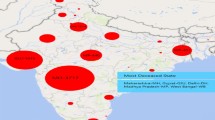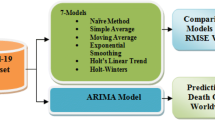Abstract
Coronavirus started to spread in December 2019, especially in China, then rapidly it began to spread worldwide. COVID-19 mainly targets the elderly, the weak immune and the chronically ill people. Until now scientists could not determine the behavior of the virus to fight it and limit its reproduction and spread among humans. This steady increase in infected and dead people has exhausted the medical staff and led to the collapse of health sectors in the major countries and made them suffer from acute shortages of places and medical supplies. In order to anticipate the number of future infected and dead people, we have used in this paper short-term forecasting algorithms to predict the number of infected and deaths in the short future. The forecasting is conducted using the following forecasting algorithms: auto-regressive integrated moving average (ARIMA), hybrid ARIMA, HoltWinters and exponential smoothing with horizon value equalling 57 days. After evaluating the tested algorithms using MAPE, it is noticed that exponential smoothing was the best forecasting algorithm to be used to predict recovered cases with MAPE 2.66% and to forecast confirmed cases with MAPE equal to 1.77%, and HoltWinters is the best algorithm to be used to predict dead cases with MAPE equal to 5.33%.
Access this chapter
Tax calculation will be finalised at checkout
Purchases are for personal use only
Similar content being viewed by others
References
WHO Director-General's remarks at the media briefing on 2019-nCoV on 11 February 2020 [updated 11/02/2020]. https://www.who.int/dg/speeches/detail/who-director-general-s-remarks-at-the-media-briefing-on-2019-ncov-on-11-february-2020
2019–2020 coronavirus pandemic. https://en.wikipedia.org/wiki/2019%E2%80%9320_coronavirus_pandemic
Confirmed coronavirus cases top 3m worldwide. https://www.aljazeera.com/news/2020/04/italy-loosen-lockdown-4-coronavirus-live-updates-200426233610783.html
Goo N H (2020) Committee [updated 26/02/2020]. http://bgs.satcm.gov.cn/zhengcewenjian/2020-02-06/12847.html.
Bai Y, Yao L, Wei T, Tian F, Jin D-Y, Chen L, et al (2020) Presumed asymptomatic carrier transmission of COVID-19 323(14):1406–1407
Mukhairez HHA (2018) Long-term forecasting for world oil production. Int J Intell Comput Res 9
Alimadadi A, Aryal S, Manandhar I, Munroe PB, Joe B, Cheng X (2020) Artificial intelligence and machine learning to fight COVID-19. American Physiological Society Bethesda, MD
Barstugan M, Ozkaya U, Ozturk S (2020) Coronavirus (covid-19) classification using ct images by machine learning methods
Yang Z, Zeng Z, Wang K, Wong S-S, Liang W, Zanin M, et al (2020) Modified SEIR and AI prediction of the epidemics trend of COVID-19 in China under public health interventions 12(3):165
Gulamali F (2020) AlphaFold algorithm predicts COVID-19 protein structures [updated 31/3/2020]. https://www.infoq.com/news/2020/03/deepmind-covid-19/
Broomhead DS, King GP (1986) Extracting qualitative dynamics from experimental data 20(2–3):217–236
Khashei M, Bijari MJM (2011) Engineering Si: a new hybrid methodology for nonlinear time series forecasting
Chatfield CJJotRSSSC (1978) The Holt‐winters forecasting procedure. 27(3):264–279
Gardner Jr ES (1985) Exponential smoothing: the state of the art 4(1):1–28
Novel Coronavirus 2019 time series data on cases. https://github.com/datasets/covid-19/blob/master/data/time-series-19-covid-combined.csv
Nabi KN (2020) Forecasting COVID-19 pandemic: a data-driven analysis. Elsevier
Cooper I, Mondal A, Antonopoulos CG (2020) Dynamic tracking with model-based forecasting for the spread of the COVID-19 pandemic. Elsevier
Author information
Authors and Affiliations
Editor information
Editors and Affiliations
Rights and permissions
Copyright information
© 2022 The Author(s), under exclusive license to Springer Nature Singapore Pte Ltd.
About this chapter
Cite this chapter
Mukhairez, H.H.A., Alaff, A.J.I. (2022). Short-term Forecasting of COVID-19. In: Kose, U., Watada, J., Deperlioglu, O., Marmolejo Saucedo, J.A. (eds) Computational Intelligence for COVID-19 and Future Pandemics. Disruptive Technologies and Digital Transformations for Society 5.0. Springer, Singapore. https://doi.org/10.1007/978-981-16-3783-4_12
Download citation
DOI: https://doi.org/10.1007/978-981-16-3783-4_12
Published:
Publisher Name: Springer, Singapore
Print ISBN: 978-981-16-3782-7
Online ISBN: 978-981-16-3783-4
eBook Packages: Intelligent Technologies and RoboticsIntelligent Technologies and Robotics (R0)




